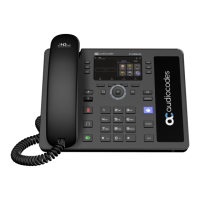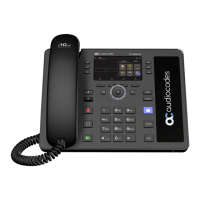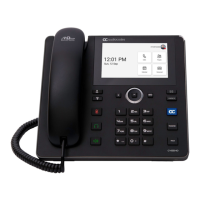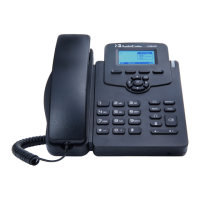Do you have a question about the AudioCodes C470HD and is the answer not in the manual?
Summarizes phone's software specifications.
Network admin configuration for security settings.
Security practices for Android-based devices.
Major Android-level system developments for security.
Describes checking contents and handling missing/broken items.
Identifies and familiarizes with device hardware functions.
Describes the front view of the phone with labeled components.
Describes the ports located on the rear of the phone.
Refers to Quick Guide for detailed cabling information.
Describes desk mounting options for the phone.
Recommends cleaning device screens.
Familiarizes with phone settings and customization options.
Details configuration of Wi-Fi parameters.
Steps to connect to an available Wi-Fi network.
Steps to manually add a network via SSID.
Procedures for resetting the phone to factory defaults.
Steps for restoring settings while phone is running.
Steps for performing a soft restore via Admin login.
How to boot the phone in recovery mode.
Features and steps for locking/unlocking the device.
Describes the process of signing into the Teams application.
Authentication into specialized clouds.
Remotely provisioning and signing in devices.
Familiarization with the phone's user interface.
Enabling accessibility feature for blind/low-vision users.
Feature allowing users to sign into a shared device.
Controlling visibility by assigning presence status.
Describes various Teams application settings.
Steps to set up meetings from the phone.
Connecting and collaborating with contacts.
Steps to access voicemail messages.
Describes how to make calls in multiple ways.
Process for initiating emergency calls.
Viewing history of missed, received, and dialed calls.
Transferring a call to a "parking lot" for later pickup.
Calendering and initiating multi-party meetings.
Controls for ring, tones, handset, speaker, headset volumes.
Viewing scheduled meetings and joining them.
Configuring Bluetooth for PC client integration.
Directing phones to provisioning servers.
Configuring emergency locations in the admin center.
Using Android Phone Utility to update firmware.
Loading user certificates via Device Manager or Utility.
Performing recovery via long-pressing reset key.
Managing phones via AudioCodes Device Manager.
Setting time zone and DST.
Establishing HTTPS connection for devices.
Differentiated Services Code Point for QoS monitoring.
Troubleshooting common user issues and procedures.
Troubleshooting for network administrators.
Utility for debugging network admin tasks.
Enabling and using remote logging.
Obtaining diagnostic information for debugging.
Activating DSP recording for audio issues.
Accessing phone via Secure Shell protocol.
| Wi-Fi | Yes |
|---|---|
| Wi-Fi standards | 802.11b, 802.11g, Wi-Fi 4 (802.11n) |
| Bluetooth version | 5.0 |
| Security algorithms | 802.1x RADIUS, HTTPS, TLS |
| Networking standards | IEEE 802.3af |
| Ethernet LAN data rates | 10, 100, 1000 Mbit/s |
| Ethernet LAN interface type | Gigabit Ethernet |
| Voice codecs | G.711, G.722, G.729, SILK |
| Storage temperature (T-T) | -20 - 70 °C |
| Operating temperature (T-T) | 0 - 40 °C |
| Display diagonal | 5.5 \ |
| Display resolution | 720 x 1280 pixels |
| AC adapter input voltage | 100 - 240 V |
| AC adapter output current | 2 A |
| AC adapter output voltage | 12 V |
| Lines quantity | - lines |
| Phonebook capacity | - entries |
| Number of VoIP accounts | - |
| RJ-9 ports quantity | 1 |
| WAN connection type | RJ-45 |
| USB 2.0 ports quantity | USB 2.0 ports have a data transmission speed of 480 Mbps, and are backwards compatible with USB 1.1 ports. You can connect all kinds of peripheral devices to them. |
| Ethernet LAN (RJ-45) ports | 2 |
| Operating system version | 9.0 |
| Operating system installed | Android |
| Mounting | Desk |
| Handset type | Wired handset |
| Product type | IP Phone |
| Product color | Black |
| Wall mountable | No |
| Cables included | LAN (RJ-45) |
| Number of handles included | 1 pc(s) |
| Sustainability certificates | Federal Communications Commission (FCC) |
| Master (outer) case width | 490 mm |
| Master (outer) case height | 308 mm |
| Master (outer) case length | 540 mm |
| Master (outer) case weight | 12350 g |
| Depth | 165 mm |
|---|---|
| Width | 180 mm |
| Height | 230 mm |
| Weight | 1200 g |
| Package depth | 275 mm |
| Package width | 238 mm |
| Package height | 174 mm |
| Package weight | 1741 g |











